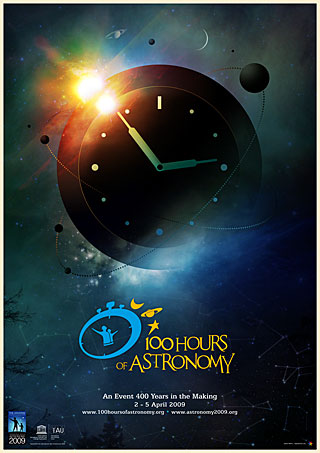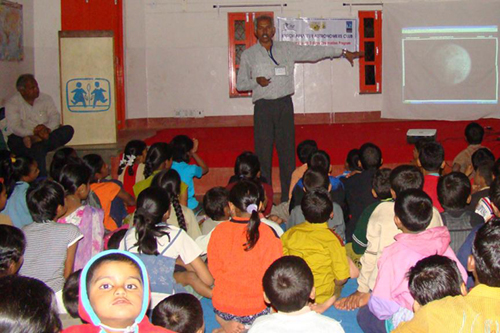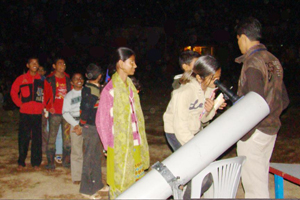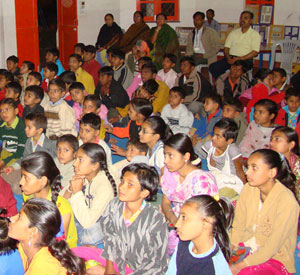IYA2009 Updates
Small Solar System Body Named After IYA2009
18 February 2009

The International Astronomical Union Working Group on Small Bodies Nomenclature has decided to name a minor Solar System body after IYA2009. Its official designation is now (58664) IYAMMIX. The year 2009 is written in Roman numerals, MMIX, following the official guidelines for small Solar System bodies naming.
Discovered on 21 December 1997 by J. Ticha and M. Tichy at the Klet Observatory in Czech Republic, IYAMMIX, formerly known as 1997 YA1, takes 3.65 years to complete one of its elliptical orbits around the Sun. The orbit is inclined by 4.1 degrees to the ecliptic plan. Its diameter is thought to be in the region of 2 to 4 km. Not much more is known about (58664) IYAMMIX, making it a mysterious world waiting to be researched, mirroring IYA2009's motto: "The Universe, Yours to Discover."
The image of small Solar System body IYAMMIX = 1997 YA1 was taken on 30 December 1997 using the 0.57m f/5.2 reflector + CCD camera SBIG ST-8 of the Klet Observatory (South Bohemia, Czech Republic). The exposure was 60 seconds long, and the minor planet has been arrowed. The field of view is 16 to 10 arcminutes with north to the top and west to the right. Credit: Jana Ticha and Milos Tichy.

Orbit of the minor planet (58664) IYAMMIX discovered at the Klet Observatory. Credit: Klet Observatory (South Bohemia, Czech Republic).
IAU Division III - Committee on Small Body Nomenclature webpage: http://www.ss.astro.umd.edu/IAU/csbn/
IYA2009 Update
13 February 2009
Dear Friends,
Some short updates from the past week:
100 Hours of Astronomy:
- Press Release: 100 Hours of Astronomy project kicks off! IYA2009) is about to reach new heights as the Global Cornerstone Project, 100 Hours of Astronomy, scheduled to take place from 2-5 April 2009, ramps up. The project invites amateur astronomers, educators, professional astronomers, planetaria, science centres and more to arrange events around the world during this 4-day period and to publicise them now on the project website. For those wishing to visit the frontiers of astronomy from their home, a 24-hour webcast from the largest telescopes on the planet will take a unique look behind the scenes at state of the art research facilities. http://www.astronomy2009.org/news/pressreleases/detail/iya0904/
- 100 Hours of Astronomy Cornerstone Project UPDATE!: The excitement is building for the 100 Hours of Astronomy project, an unprecedented outreach event taking place around the world 2 - 5 April. The 100 Hours of Astronomy Task Group has many resources and programs available on the official web site at http://www.100hoursofastronomy.org. We hope you'll visit to see what's available and spread the word to people in your country or organization: http://www.astronomy2009.org/news/updates/150/
- 100 Hours of Astronomy Poster: IYA2009 is about to reach new heights as the Global Cornerstone Project, 100 Hours of Astronomy, scheduled to take place from 2-5 April 2009, ramps up. And now thanks James White, 100HA has a new amazing poster: http://www.astronomy2009.org/news/updates/149/
JENAM2009 Symposium: IYA2009 in Europe, JENA2009, 20 - 23 April 2009, Uni. Hertfordshire, UK The International Year of Astronomy 2009 is a fantastic opportunity for astronomers around the world, and in particular, in Europe to showcase the excitement and challenges of astronomy today. This symposium focuses on two key aspects of IYA2009: outreach in terms of communicating astronomy with the public; the educational value of astronomy in attracting young people into science and technology studies at school and beyond. The latter is deliberately meant to be wide-ranging, from the very young, covered by UNAWE, through secondary schooling and career choice beyond. A huge number of events are planned across Europe, so contributors are invited to share these exciting ideas and because much of the year will remain after the meeting, this is an excellent opportunity to learn from each other and gather new ideas for events in the latter part of the year. More information: http://www.jenam2009.eu
NASA's Great Observatories Celebrate International Year of Astronomy 2009: in conjunction with Galileo's birthday on Feb. 15, NASA is releasing images from its Great Observatories -- the Hubble Space Telescope, Spitzer Space Telescope, and Chandra X-ray Observatory -- to more than 100 planetariums, museums, nature centers, and schools across the country.: http://www.astronomy2009.org/news/updates/146/
President of the Polish Republic, Lech Kaczynski, presides over the Polish IYA2009 Honour Committee. More info: http://www.astronomia2009.pl/2/index.php?id=3
Report on StarPeace event between India and Pakistan: On February 9, during a penumbral lunar eclipse, StarPeace connected two countries, Pakistan and India, together. Society of the Sun in Pakistan and Kutch Amateur Astronomy Club in India organized this event successfully in SOS villages of both countries: http://www.astronomy2009.org/news/updates/148/
British 1894 Astronomer Royal becomes new Cosmic Diary blogger: The Cosmic Diary, has a new participant: Great Britain's Astronomer Royal from the year 1894, William Henry Mahony Christie. He will be joined by his two assistants, Herbert Hall Turner and Frank Watson Dyson, as they each blog in text and images about their lives and work at the Greenwich Observatory via the official website: http://www.astronomy2009.org/news/updates/151/
IYA2009 News Round-up: http://www.astronomy2009.org/news/updates/152/
Valcato Hosting: To celebrate IYA2009, Valcato Hosting is offering one year of free web hosting for any and all astronomy websites!: http://www.valcatohosting.com/
StarLight: A Common Heritage: Declaration in Defence of the Night Sky and the Right to Starlight and Starlight, A Common Heritage Book are available in PDF: http://www.starlight2007.net/
If you need any assistance, remember that the Secretariat is always available for you.
Kind regards,
Pedro and Mariana
IYA2009 Secretariat
IYA2009 News Round-Up, 13 February 2009
13 February 2009
It's news round-up time! Brought to you today from an internet cafe, as I was made promises about internet instillation times that were not kept. But fear not, there's no stopping the IYA2009 updates!
It's always good to see local stories about IYA2009 events get some coverage in the media, so let's show our appreciation by hyperlinking to Chronicle-Tribune which is advertising a free show at the Marion Public Library, Grant County, Indiana. The programme in question is entitled "Visions of the Universe: Four Centuries of Discovery", and we are informed that it was created in honour of IYA2009. So it definitely deserves a mention here. The Mail Tribune has also been highlighting IYA2009 activities in the Southern Oregon area.
The Hindu reports that The State unit of Jana Vignana Vedika and Birla Science Centre is gearing up for two-day long activities to mark the quarter-centenary celebrations of invention of telescope by Galileo Galilei. The actual article is very short, and most of it has just been reproduced here.
Astronomy.com has posted a brief article about NASA releasing images from its great observatories (Hubble, Spitzer, Chandra) to more than 100 planetariums, museums, nature centres and schools. The photos will be out of this world, ahaha.
2009 is an excellent time for amateur astronomers, as Mark Thompson would agree. His hobby has been under the spotlight in a feature for Norwich Evening News. Apparently, the home of Alan Partridge is also a centre for astronomy enthusiasts, as evidenced by the great number of activities planned in the area for IYA2009. Seeing conditions must be pretty good, if Mark's photos are anything to go by.
And finally, WRS Radio have kindly uploaded an audio file about astronomy in Switzerland, which is deserving of your attention if you are a) Swiss and b) fed up of reading words.
That's all there's time for this week. Quite literally, I'm about to be kicked out of the internet cafe for making my single drink last over two hours.
Lee Pullen
IYA2009 Staff Writer
British 1894 Astronomer Royal becomes new Cosmic Diary blogger
13 February 2009
The Cosmic Diary, a Cornerstone Project of the International Year of Astronomy 2009 will have a new participant from 18 February: Great Britain's Astronomer Royal from the year 1894, William Henry Mahony Christie. He will be joined by his two assistants, Herbert Hall Turner and Frank Watson Dyson, as they each blog in text and images about their lives and work at the Greenwich Observatory via the official website: www.cosmicdiary.org.
Of course, these astronomers won't really be blogging, as they died long ago. Rather, current Royal Observatory Greenwich staff will be using journals and other historical documents to adopt the guise of Christie, Turner and Dyson. It's all part of the Cosmic Diary, a project which aims to put a human face on the science of astronomy. Alongside Christie and co. are over 60 modern professional astronomers, currently blogging about their daily lives, the work they conduct, and the challenges they face. Members of the public can see what being an astronomer is really like, and how ground-breaking research is conducted.
Since its launch on 1 January 2009, the Cosmic Diary has received more than 25,000 hits from visitors in 152 countries. The huge potential of the project made waves in the scientific community. NASA, The European Space Agency, the European Southern Observatory, and the Japan Aerospace Exploration Agency requested their own sub-blogs which are hosted on the official site, broadening its reach even further. The contribution from the Royal Observatory Greenwich will give a historical flavour to proceedings, and highlight how much has changed since the day of Christie.
Mariana Barrosa, Cosmic Diary Chair, comments: "we're all very excited to have the Royal Observatory Greenwich team join the Cosmic Diary. This historical twist is an excellent way of showing the public that scientists are ordinary people, and that astronomy is a fascinating subject. It may even inspire some to pursue it as a career!"
The Cosmic Diary website, www.cosmicdiary.org, is certainly one to watch during the International Year of Astronomy 2009!
100 Hours of Astronomy Cornerstone Project Update
13 February 2009
100 Hours of Astronomy Cornerstone Project UPDATE!
The excitement is building for the 100 Hours of Astronomy project, an unprecedented outreach event taking place around the world 2 - 5 April. The 100 Hours of Astronomy Task Group has many resources and programs available on the official web site at http://www.100hoursofastronomy.org. We hope you'll visit to see what's available and spread the word to people in your country or organization.
Contacts
Do you have a Coordinator for 100 Hours of Astronomy in your country? If so, we'd like to list that person as a contact on our web site. Please send contact information to Jennie McCormick at farmcoveobs@xtra.co.nz. Do you have someone else as a contact for amateur astronomers for your national node? Let Jennie know and we'll list that person on our contact page.
Logos in your language
Do you want a version of the 100 Hours of Astronomy logo in your language? Send a translation of "100 Hours of Astronomy" encoded UTF-8, including the font, if necessary, to Jennie McCormick at farmcoveobs@xtra.co.nz. Deadline: 18/2
24-hour Global Star Party
Did you know International Sidewalk Astronomy Night (ISAN) is also taking place on April 4? ISAN planned their annual event to coincide with the 24-hour global star party to help make it a success. ISAN volunteers around the world are working hard to contact and include as many sidewalk astronomers as possible to take part. If you are organizing events for 100 Hours of Astronomy and would like these dedicated members of the astronomy outreach community to help, you can find their contact information on our web site.
New -- SunDay
A new program has been added to the overall program for the 100 Hours of Astronomy. In collaboration with 100 Hours of Astronomy, the IYA2009 Solar Physics Task Group has declared Sunday, 5 April as SunDay, a day to focus on bringing attention to our nearest star. Visit the Solar Physics Task Group's web site at http://solarastronomy2009.org/100-hours-sunday for more information.
Event Registration
Are you registering 100 Hours of Astronomy events on your web site? That's great, but please make sure they are registered on the 100 Hours of Astronomy web site, too. Much of the public and news media will be coming to our site and we want to be sure everyone can find events in every country. We're also going to be tracking the number of events and following up to get information on how everything went, and we need to know about everyone's plans to be able to do that. Sponsors and partners need the information for their planning, too. So please spread the word in your country or organization that events should be registered on the 100 Hours of Astronomy web site. Go to http://www.100hoursofastronomy.org/eventsmain to register events.
Merchandise available online at the 100 Hours of Astronomy shop
The Resource section of the 100 Hours of Astronomy web site has a lot of useful items available including labels, stickers, posters, stationery and more. They're all ready to be downloaded, printed and used to identify your events as part of the 100 Hours of Astronomy.
Now you can buy merchandise ready to go, too. The 100 Hours of Astronomy shop on Café Press has shirts, hats, buttons and more emblazoned with artwork specially created for each style and color. Go to our shop at http://www.cafepress.com/100HA and show the world you're getting ready to take part in this global celebration of astronomy.
Download artwork for clothing
If you prefer to create your own 100 Hours of Astronomy items visit our Resource page at http://www.100hoursofastronomy.org/all-content to download the special artwork, ready to use.
World map of events for your web site
You can now customize the world map of 100 Hours of Astronomy events and add it to your own web site. Go to http://www.100hoursofastronomy.org/component/content/article/91#embedding to learn how.
New web site features
The 100 Hours of Astronomy web site now has some new features to engage the community, broadcast information and gather new ideas. A blog will have entries of interest on developments and interesting, innovative events being planned around the world. The forum can be used to ask questions, get help from experience event planners and share new ideas with others. The photo gallery augments the forum by allowing users to post images of events that might inspire or help others in planning, as well as sharing the excitement as we build towards this great global event. Visit the 100 Hours of Astronomy web site at http://www.100hoursofastronomy.org, take part and watch the excitement grow.
If you have any questions, please don't hesitate to contact us!
Kind regards,
Mike Simmons
E-mail: msimm@ucla.edu
100 Hours of Astronomy Cornerstone Chair
Pedro Russo
IYA2009 Coordinator
100 Hours of Astronomy Poster
12 February 2009

The International Year of Astronomy 2009 (IYA2009) is about to reach new heights as the Global Cornerstone Project, 100 Hours of Astronomy, scheduled to take place from 2-5 April 2009, ramps up. The project invites amateur astronomers, educators, professional astronomers, planetaria, science centres and more to arrange events around the world during this 4-day period and to publicise them now on the project website. For those wishing to visit the frontiers of astronomy from their home, a 24-hour webcast from the largest telescopes on the planet will take a unique look behind the scenes at state of the art research facilities.
Poster available in different formats: http://www.astronomy2009.org/resources/posters/detail/poster_100hours/
More information: www.100hoursofastronomy.org
Credit: James White/signalnoise.com/IAU/IYA2009
(Thanks James for the amazing poster!)
Report on StarPeace event between India and Pakistan
11 February 2009

On February 9, during a penumbral lunar eclipse, StarPeace connected two countries, Pakistan and India, together. Society of the Sun in Pakistan and Kutch Amateur Astronomy Club in India organized this event successfully in SOS villages of both countries.
Narendra Sagar Gor form Kutch Amateur Astronomy Club held the event in Bhuj SOS children village, India, for about 70 children and their teachers. The program begins with introduction speeches on the basics of the eclipse. After that children went outdoors and observe the moon by telescope.

Meanwhile, a few kilometers away, children in Lahore SOS children village, Pakistan, were attending in astronomy lectures and workshops. Hassaan Ghazali from The Society of Sun taught them the basics of the eclipse, moon phases, Solar System planets, etc. Due to bad weather conditions children saw the moon just after rising over the horizon but unfortunately it soon disappeared behind clouds.

During these two events Narendra Gor and Hassaan Ghazali made a phone connection. While children in Lahore yelled "We are your friends", children in Bhuj were so excited and one of them talked to Hassaan Ghazali and told him she was enjoying the event thoroughly. Children in two countries were so excited and happy that they persisted to have such programs again.

On one of the posters in Lahore these words were written: "One Sun, One Earth, No Borders!" StarPeace project's goal is to promote peace between nations and to show that there is no real border between humans, just like the sky in which there is no border lines! Where ever you are the sky is the same.
"Where I am, let it be so, the sky is mine" (Sohrab Sepehri)
Photos and detailed report on Pakistan event: http://www.starpeace.org/En/Events/Pakistan/Default.aspx
Photos and detailed report on India event: http://www.starpeace.org/En/Events/India/Default.aspx
Irene Shivaei
StarPeace Project Member of Board
website: www.starpeace.org
100 Hours of Astronomy Newsletter
11 February 2009
100 Hours of Astronomy "Keeping in Touch" Newsletter No.3 Feb 2009 [PDF]
NASA's Great Observatories Celebrate International Year of Astronomy 2009
10 February 2009
Galileo first turned his telescope to the heavens in 1609, marking the dawn of modern astronomy. To commemorate 400 years of exploring the universe, 2009 has been designated the International Year of Astronomy.
In conjunction with Galileo's birthday on Feb. 15, NASA is releasing images from its Great Observatories -- the Hubble Space Telescope, Spitzer Space Telescope, and Chandra X-ray Observatory -- to more than 100 planetariums, museums, nature centers, and schools across the country.
The selected sites will unveil a large, 9-square-foot print of the spiral galaxy Messier 101 that combines the optical view of Hubble, the infrared view of Spitzer, and the X-ray view of Chandra into one multiwavelength picture. "It's like using your eyes, night vision goggles, and X-ray vision all at the same time," said Dr. Hashima Hasan, lead scientist for the International Year of Astronomy at NASA Headquarters in Washington. Participating institutions also will display a matched trio of Hubble, Spitzer, and Chandra images of Messier 101. Each image shows a different wavelength view of the galaxy that illustrates not only the different science each observatory conducts but also how far astronomy has come since Galileo.
Messier 101 is a spiral galaxy about 22 million light-years away in the constellation Ursa Major. It is larger than our own Milky Way galaxy but similar in many ways. Hubble's visible-light view shows off the swirls of bright stars and glowing gas that give Messier 101 its nickname "the Pinwheel Galaxy." In contrast, Spitzer's infrared-light image sees into the spiral arms and reveals the glow of dust lanes where dense clouds can collapse to form new stars. Chandra's X-ray uncovers the high-energy features in the galaxy, such as remnants of exploded stars or matter zooming around black holes. The juxtaposition of observations from these three telescopes provides an in-depth view of the galaxy for both astronomers and the public.
"The amazing scientific discoveries Galileo made four centuries ago are continued today by scientists using NASA's space observatories," said Denise Smith, the unveiling's project manager at the Space Telescope Science Institute in Baltimore. "NASA's Great Observatories are distributing huge prints of spectacular images so the public can share in the exploration and wonder of the universe."
The unveilings will take place Feb. 14-28 at 76 museums and 40 schools and universities nationwide, reaching both big cities and small towns. Sites are planning celebrations involving the public, schools, and local media.
The Astrophysics Division of NASA's Science Mission Directorate supports the International Year of Astronomy Great Observatories image unveiling. The project is a collaboration among the Space Telescope Science Institute, the Spitzer Science Center in Pasadena, Calif., and the Chandra X-ray Center in Cambridge, Mass.
The M101 images and a list of places exhibiting these images can be found at:
http://hubblesite.org/news/2009/07
http://hubblesource.stsci.edu/events/iya/participants.php
Find out more about NASA's contributions to the International Year of Astronomy at:
http://astronomy2009.nasa.gov
The Hubble Space Telescope is a project of international cooperation between NASA and the European Space Agency (ESA) and is managed by NASA's Goddard Space Flight Center (GSFC) in Greenbelt, Md. The Space Telescope Science Institute (STScI) conducts Hubble science operations. The institute is operated for NASA by the Association of Universities for Research in Astronomy, Inc., Washington, D.C.
IYA2009 Update
6 February 2009
Dear Friends,
Some short updates from the past days:
International Astronomical Union Symposium 260: "The Rôle of Astronomy in Society and Culture" took place in Paris, at UNESCO HQ, with a top-level scientific programme: http://iaus260.obspm.fr/
History was officially announced as exclusive international television partner of the IYA2009. This partnership aligns with the IYA2009 Secretariat's objectives of increasing the visibility and maximizing the reach of the IYA2009, reaching large audiences and key markets around the world: http://www.astronomy2009.org/news/updates/135/
First IYA2009 Patron: Mani Bhaumik is the first IYA2009 Patron and we are proud to have him as a dedicated supporter of IYA2009's global activities: http://www.astronomy2009.org/organisation/structure/partners/patron/
IYA2009 - initiative of interest in Paraguay: IYA2009 has been declared initiative of interest by the Paraguayan Ministers of Tourism and Culture: http://www.astronomia2009.org.py/noticias_completa.php?samuel=20
IYA2009 Songs: New IYA2009-themed songs are now available to download, ranging from the official anthem used in the trailer, to the opening of the 365 Days of Astronomy podcasts: http://www.astronomy2009.org/resources/multimedia/audio/
Hubble's Next Discovery - You Decide: People around the world can vote to select the next object the Hubble Space Telescope will view. Choose from a list of objects Hubble has never observed before and enter a drawing for one of 100 new Hubble pictures of the winning object. The winning image will be released during the 100 Hours of Astronomy: http://youdecide.hubblesite.org/
Celebrating the 1919 Eclipse at Príncipe: New website for the IYA2009 Special Project: http://www.1919eclipse.org/
IYA2009 News Round-up: http://www.astronomy2009.org/news/updates/144/
Spanish IYA2009 Promotional Spot: Check the Spanish IYA2009 Promotional Spot in 5 different languages: http://www.astronomia2009.cat/bin/view/Main/PaginaVideosENG In English: http://www.astronomy2009.org/resources/multimedia/videos/detail/iya2009_es_video/
IYA2009 Official Products:
- The Cosmic Detective: The IYA2009 fully endorses this book for people of all ages and believes it will help the general public to realise the wondrous knowledge about our Universe and our place in it. To reach the widest possible audience, the Secretariat encourages all SPoCs to seek publishers for The Cosmic Detective in their home countries. http://www.astronomy2009.org/resources/products/cosmicdetective/
- Redshift 7 Premium: The Planetarium software which leaves nothing to wish for! You, as an IYA2009 stakeholder now have the opportunity to buy this software with 50% discount. http://www.astronomy2009.org/resources/products/redshift/
- Eyes on the Skies DVD: The second edition of the International Astronomical Union's movie celebrating the 400th anniversary of the telescope is in the making, with even more language subtitle and narrations. http://www.astronomy2009.org/resources/products/eyes/
- The 400 Years of the Telescope: an exciting multimedia celebration of Galileo's first telescopic observations of the cosmos, and the resulting journey of discovery for humanity. High definition documentary, 400 Years of the Telescope, to be distributed internationally for broadcast in 2009. A Cinematic version will be available for theatre and IMAX theatres. http://www.astronomy2009.org/resources/products/400years/
- SkyScout: Celestron's Personal Planetarium. About the size of a camcorder and weighing less than 300 grams, the SkyScout utilizes a consumer-friendly "point and shoot" GPS technology that enables stargazers to instantly identify and/or locate over 50,000 celestial objects in the sky with the press of a button and listen to commentary on the object and its history. Special prices just for you, don't miss this opportunity! http://www.astronomy2009.org/resources/products/skyscout/
- Star Walk: Explore the Universe with Star Walk, the star gazing software for iPhone. http://www.astronomy2009.org/resources/products/starwalk/
If you need any assistance, remember that the Secretariat is always available for you.
Kind regards,
Pedro and Mariana
IYA2009 Secretariat
Search IYA2009 Updates

National Nodes: 148
Organisational Nodes: 40
Organisational Associates:33
National Websites: 111
Cornerstone Projects: 12
Special Task Groups: 11
Special Projects:16
Official Products:8
Media Partners:22


